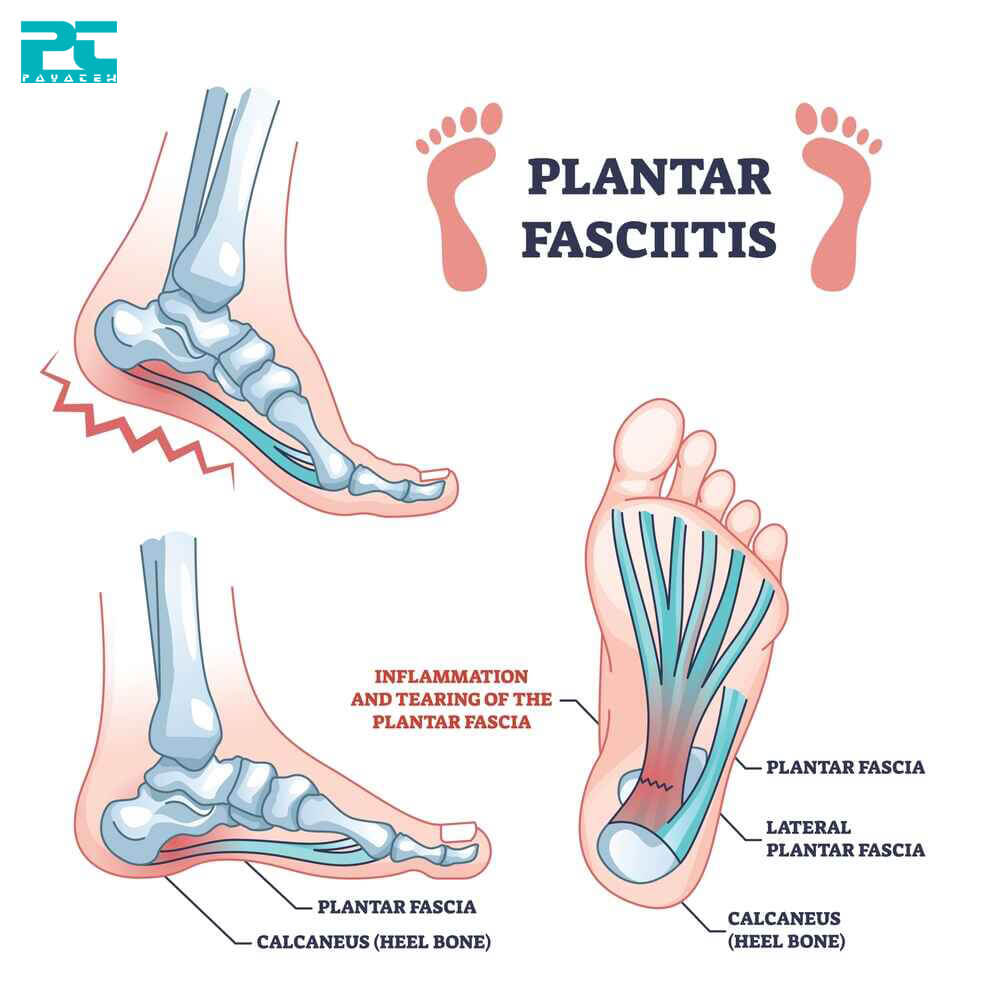Articles
What is plantar fasciitis?
Plantar fasciitis is a degenerative condition characterized by pain in the heel. It involves inflammation and irritation of the plantar fascia, a thick band of tissue that supports the arch of the foot and connects the heel bone to the toes. The condition commonly causes stabbing pain, particularly with the first steps in the morning, which may decrease as one starts to move but can return after prolonged standing or when standing up after sitting. Plantar fasciitis is one of the most common causes of heel pain.


What causes plantar fasciitis?
Anything that irritates or damages your plantar fascia can cause plantar fasciitis, including:
- Overstretching or overuse of the plantar fascia ligament, which can lead to irritation or small tears in the fascia tissue.
- Foot structure, such as being flat-footed or having high arches, which can increase the risk of developing plantar fasciitis.
- Engaging in sports or activities that put stress on the heel bone, like running, dancing, or aerobics.
- Being middle-aged or older.
- Being overweight.
- Pregnancy, especially during late stages.
- Spending long periods of time on the feet.
- Wear shoes with poor arch support or stiff soles.
- Having tight calf muscles.


Factors that irritate or damage the plantar fasciitis
Factors that can contribute to the development of plantar fasciitis include:
- Being on feet all day for work.
- Playing sports.
- Exercising or working on hard surfaces.
- Exercising without proper stretching or warm-up.
- Wearing unsupportive shoes.
- Walking or standing barefoot for extended periods.
- Certain health conditions, such as having high arch feet, flat feet, or obesity.
Excessive pressure on the plantar fascia can lead to tissue damage and tears, triggering the body’s inflammatory response and resulting in the characteristic heel pain and stiffness associated with plantar fasciitis.


Symptoms
Common symptoms of plantar fasciitis include:
- Stabbing pain in the bottom of the foot near the heel
- Worsening pain with the first few steps after awakening
- Increasing pain with prolonged standing, or after intense activity
- Aching or burning sensation in the foot sole and slight swelling in the heel
- Gradually developing pain that can be dull, sharp, or accompanied by a burning or ache sensation


How is plantar fasciitis diagnosed?
Your doctor may prescribe an X-ray, which produces images of your bones, to rule out other causes of foot pain, such as a stress fracture. He may prescribe an ultrasound or an MRI that produces images of soft tissues. These imaging exams can reveal whether an irritated or inflamed nerve, rather than an inflammatory fascia, is the source of the pain, which is particularly true when nonsurgical treatments haven’t previously made the discomfort less severe.
Innovative devices such as the PayaTek foot pressure scanner offer valuable data that aids specialists in precisely identifying plantar issues, including plantar fasciitis.
Plantar fasciitis typically resolves within a few months through conservative approaches like icing, stretching, and activity modification. However, there are additional methods available:
Orthotics or Shoe Inserts: Inserts that offer extra arch support can be added to your shoes. These may include over-the-counter pre-made inserts or custom orthotics tailored to the contours of your foot.
Immobilization: Wearing a walking boot, also known as a walking cast or pneumatic cam walker, for several weeks can provide relief by reducing pressure on the plantar fascia. The duration of boot usage will be determined by your healthcare provider.
Shock Wave Therapy: This treatment involves delivering low- or high-energy shock waves to the affected area. These waves induce microscopic trauma, triggering the body’s healing response. This process is believed to aid in healing the plantar fascia.
Steroid Injections: While most cases of plantar fasciitis improve with stretching over a few months, persistent symptoms may warrant steroid injections to reduce inflammation, particularly if symptoms persist beyond two months of treatment.
It’s essential to consult a medical professional to determine the most suitable treatment strategy for your individual condition.
Plantar fasciitis stretches and exercises
Plantar fasciitis stretches are among the most effective exercises for managing foot pain, particularly in the morning and after physical activities. To maximize the benefits of stretching, incorporate plantar fasciitis exercises multiple times throughout your day. Here, we offer three stretches for you to try.


Towel stretch
This exercise stretches the fascia and Achilles tendon and can prevent morning foot pain. So, consider sleeping with a towel near your bed. Here’s how it works:
- Sit with your legs extended and knees straight.
- Place a towel around your foot just under the toes.
- Hold the two ends of the towels, one in each hand, above your knees.
- Pull back with the towel so that your foot stretches toward you.
- Hold the position for at least 15 to 30 seconds, then repeat the stretch two to four times.
- Repeat up to five times a day.
Frozen water bottle rolling
Rolling a ball, water bottle or foam roller under the arch of your foot can relieve plantar fasciitis pain. Using a frozen water bottle is an especially great option because it provides ice therapy while you stretch your foot. Here’s what to do:
- Place the frozen water bottle on the floor.
- Position your foot so that the curve of the bottle is in between the ball of your foot and your heel.
- Using as much force as comfortable, roll the bottle underneath your foot.
- Continue rolling for about five minutes.
- Repeat up to three times per day.
Stair stretch
This exercise flexes both the plantar fascia and calf muscle. The goal of the stair stretch is to improve flexibility and reduce heal pain. These are the steps:
- Stand on the bottom step as if you’re planning on walking up the stairs.
- Hold onto the railing and move your feet back so that only your toes and the balls of your feet are on the stairs.
- Slowly let your heels down over the edge of the step as you relax your calf muscles. You should feel a gentle stretch across the bottom of your foot and up the back of your leg to your knee.
- Hold the stretch about 15 to 30 seconds, then tighten your calf muscle a little to bring your heel back up to the level of the step.
- Repeat two to four times each day.
Conclusion
Plantar fasciitis is a common and often painful condition that can affect anyone, but it’s particularly prevalent among those who engage in activities that place stress on the heel and arch of the foot. While the hallmark symptom is heel pain, early recognition of warning signs is crucial. These signs include discomfort when first stepping out of bed in the morning or after periods of inactivity.
To address plantar fasciitis, various treatments and exercises are available, including orthotics, immobilization, shock wave therapy, steroid injections, and stretches. Stretching exercises, in particular, play a vital role in managing the foot pain associated with this condition. Incorporating these stretches into your daily routine can alleviate discomfort and contribute to a more active, pain-free lifestyle.
Remember, if you suspect you may have plantar fasciitis or experience persistent foot pain, it’s essential to consult a medical professional for an accurate diagnosis and a tailored treatment plan. Early intervention and proactive management can lead to quicker relief and a smoother road to recovery.
